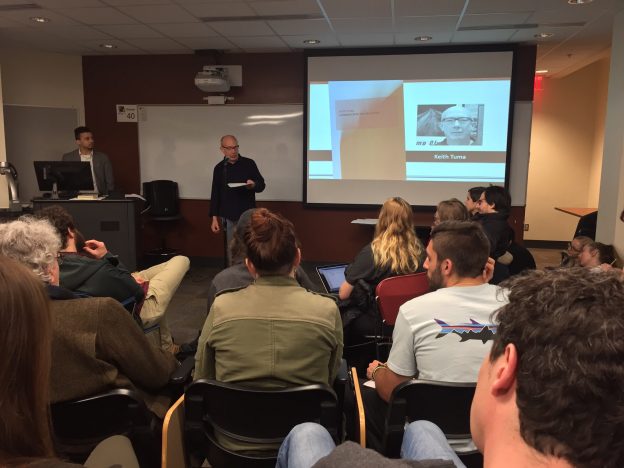Room 40 in Irvin—a small, compact space—was filled completely on the night of Wednesday, March 28th. Students piled in, resorting to standing around the room. The students and faculty talked loudly, everyone waiting with a nervous energy for the poets to begin. Using this energy, María Auxiliadora Álvarez and Keith Tuma read their respective poems, causing the audience to drift away into feelings of contemplation, sympathy, and grief, and to be startled into laughter. Both poets left the audience with more questions than answers, like any good poet does, and they both transformed room 40 into something much more than a classroom.
Dr. Álvarez read first. One of her students managed a slide-show for her on the projector screen that displayed English translations, for Dr. Álvarez’s poetry was spoken and originally written in Spanish. Even though I grew up in a predominantly Spanish speaking area in Tucson, Arizona, I have never known Spanish. I took Latin in high school, so when I hear Spanish I stop listening—my brain shutting down. This happened for the first half of Dr. Álvarez’s poems because, for me, I was transfixed by the English translation, trying to make sense of her poems’ forms and images.
But as I started to listen to Dr. Álvarez’s voice when she read the poem “Standing Stones,” I realized that I could hear a meter, and I was amazed at the emotion that sound gave to the poem. In “Standing Stones,” the concrete form of the poem helps the audience to see and feel the image of water that Dr. Álvarez creates. Dr. Álvarez writes, “If you come to its shore if its shore comes to you Enter its / night / and let yourself / sink” (lines 3-6). The form puts “and let yourself” into the middle of the line, and “sink” is placed to the far right on the next line, suggesting a floating or sinking motion. What made this image so powerful for me was her voice, for the rhythm of the Spanish created motion, reinforcing the sinking image. Dr. Álvarez’s “ Standing Stones” reconnected me to my childhood in Tucson, and I reflected on my past through the image of sinking, recalling my grandfather through the narrator of the poem. I remembered him telling me to “go through / suffering” in his own way.
I had Dr. Tuma as my first English professor at Miami, and it was a joy to be in his class. Dr. Tuma has a way with irony and humor in his teaching that made learning American Literature that much more enjoyable. His poems were no exception. His three-line tankas went back and forth, from broad topics to interactions between Tuma and his cat. Each new stanza ended with a play on words, a subtle irony, or a hidden humor that kept the audience laughing for the entire reading. An example of this would be a poem that referred to a worker taking a smoke break behind his workplace. In the poem, the workplace is a “desert” and the worker is the only one with a camel.
As a teacher, Dr. Tuma focused on ambiguities within texts, and as a poet, he’s no different. His work made me realize that writing poetry is more than an act; rather, being a poet is a way to look at the world. A poet has the ability to relate objects and stories to one another; a poet lives uniquely, illustrating the world in a way that everyone else would never think of doing. His teaching and his poetry are one in the same; he’s a teacher and a poet who questions structures in society and points out ironies and ambiguities that most of us miss. I remember in class once he laughed at someone for asking him if he wrote love poems, saying that “poetry is much more than a stupid love letter.” His poems push the bounds of language, and he showed the audience in room 40 of Irvin what it means to be a poet—someone who uses language to its fullest capability to add a new perspective to his or her audience.
Tim Doren
English Department Ambassador


